
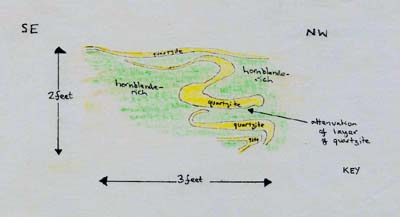

PART III: STRUCTURE
(a) FOLDING
At least two, and. probably three or more, phases of folding have affected this area. (Hopgood and Bowes, 1972 have recognised at least six, and probably seven phases in the Outer Hebrides.)
 |  | 
|
Figure 5: Sketches of the types of folds observed
The first phase postulated here (F1) is possibly demonstrated by a relic fold in a quartzite to the west of Finsbay (figure 5(i)). This small fold has a NE-SW trending axial trace. There is no evidence for this phase affecting any other rock units but the metasedimentary types to the north and south of the 'igneous complex'.
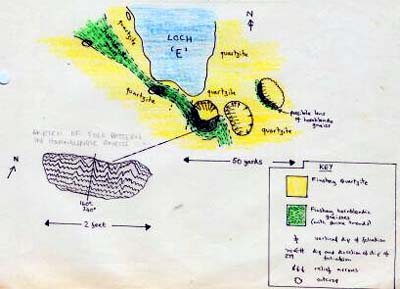
Folding in the area of Loch "E"
The second phase postulated (F2) is the dominant one of the area (probably the F3 or F4 of Hopgood and Bowes) These folds generally have WNW-ESE trending axial traces. This phase has apparently affected the rocks of the 'igneous complex' in addition to the metasediments. F2 folds are generally tight, and often angular (figure 5(i)).
The third, and probably the youngest, phase recognised (F3) has axial traces generally trending NE-SW and has apparently affected all the rock units of the area, with the exception of some of the granite pegmatites and the doleritic dykes. F3 folds are generally less angular than F2 and sometimes demonstrate 'parasitic' folds (figure 5(ii)). The boudinage observed in the hornblendic gneisses 20 yards to the north of Loch 'F' (see sketch below) is probably associated with this phase. The F3 phase folds the axial traces of F2 folds in the Ard Mor - Toan area (figures 6 and 7)
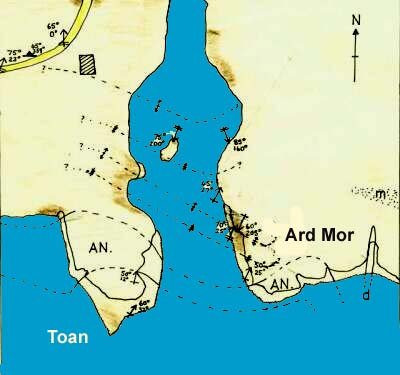 | 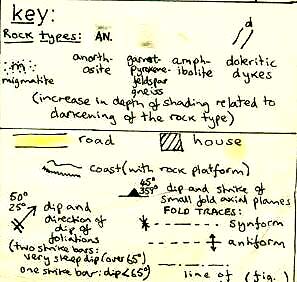
|
| Figure 6: Map of the Ard Mor - Toan area | Key |
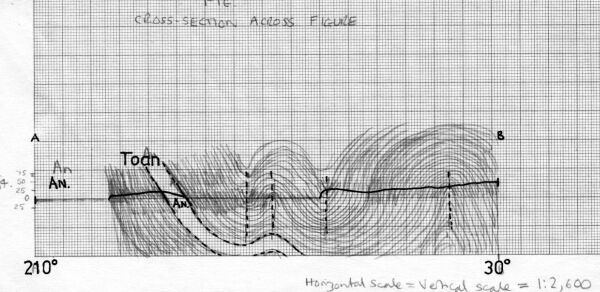
Figure 7: Cross-section of the Ard Mor - Toan area
and in the area to the ESE of Loch Langavat (figure 5(iii) and plate 7). Often the small polyphase folds show that competence differences of bands in the hornblendic gneisses may be large - the quartzitic bands being more competent than the hornblendic bands. It is the quartzitic bands which demonstrate boudinage and layer thickening and attenuation (figure 5(iii)).
 | 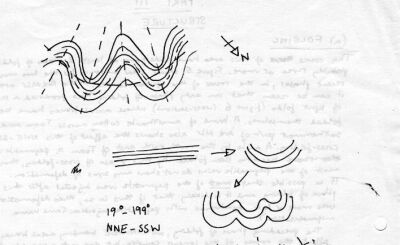
|
| Plate 7: Locality "L3" - F3 phase folds the axial traces of an F2 fold in quartzite ESE of Loch Langavat | Fig. 5(iv): Development of this fold |
The F1 phase probably occurred, before the intrusion of the 'igneous complex'. The F2 phase probably occurred, more or less simultaneously with the intrusion (evidence from strain in plagioclases of 'igneous complex' rocks suggests this). The F3 phase was probably associated with injection of the granite pegmatites, since one of the pegmatite veins is folded about a NE-SW axial trace, though others show no signs of folding.
(b) FAULTING
Some evidence of shearing is exposed on the coast between Rudha Vallarip and the Uisgearich headland. This is probably associated with the 'Minch fault' - a transform fault which trends NE-SW close to the east coast of South Harris. This is post-Laxfordian but pre-Tertiary in age, though movements probably took place between the Lower Devonian and the Upper Carboniferous (Dearnley 1962)
The only other evidence of faulting observed in this area was a small normal fault cutting the pegmatite quarry on Sletteval. This trends NNE-SSW and displaces the pegmatite a few yards southwards on the west side. Movement on this fault could have taken place at any time since intrusion of the pegmatite.